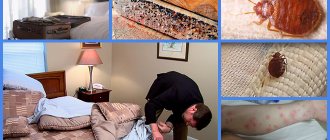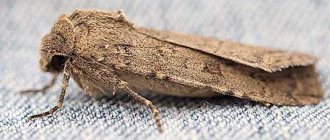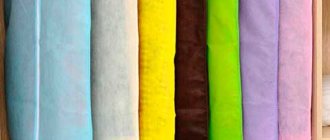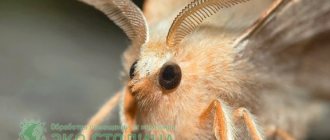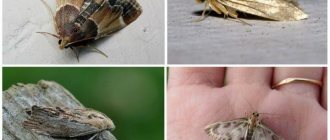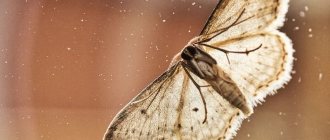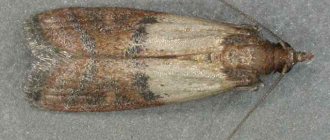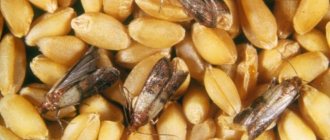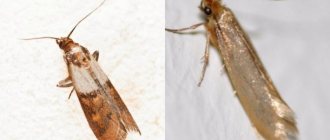A moth is an insect that persistently penetrates human homes in order to lay larvae in a secluded, warm place with plenty of available food. The insect feeds on food, as well as fur, wool, and fabrics made from natural fibers. Pantries with stocks of cereals, pasta, sweets, as well as cabinets with stored fur coats, hats, and woolen sweaters become favorite places for moths to settle.
Larvae hatching from insect eggs cause irreparable damage to human property. They chew through packaging and eat food, soiling it with their excrement. To combat this insidious insect, a thorough inspection of the apartment, disposal of damaged items, and treatment with folk and chemical preparations - “anti-moles” are required.
Types of moth larvae
To figure out what a moth larva looks like, you need to find out what type it belongs to. Experts identify several types of these pests:
- Clothes - eats felt, wool, felt and other fabrics;
- Furniture – feeds on upholstery of upholstered furniture;
- Carpet - can greatly damage carpets, paths, rugs;
- Fur coat - prefers fur;
- Kitchen - found in grains (barley, rye or wheat), often spoils dried fruits, seeds, berries, nuts and seeds.
The main difference between these individuals is precisely their preferred habitat - the clothes moth larva will not settle in cereals, grain or flour, and the kitchen caterpillar will never gnaw through clothing or textiles.
In appearance, these larvae are almost identical - they are small white or yellowish caterpillars with a brown head and clearly visible gnawing jaws. Most moth larvae are worm-like and have 6 pairs of legs. Photos will help you verify this.
The larvae can also be recognized by the structure of their “house”. Thus, the caterpillars of fur coat, carpet and clothes moths make a small cocoon from the remains of damaged textiles and a silk-like substance and put it on themselves. In this form, they are even able to move short distances. As for the larvae of furniture and kitchen moths, they create tunnels from food scraps, silk and excrement.
Moths are an invisible but insidious enemy. In a very short time, your fur coat may become unwearable.
Having recognized the pupa by its appearance, you will be able to choose effective means to destroy these pests.
Features of food (grain) moths
The cream-colored worms that sometimes spoil flour, cereals, breadcrumbs, dry kvass, and oatmeal are the larvae of food or grain moths. Caterpillars eat grain, gnawing a tunnel in it. As a result, the product turns out to be completely spoiled - in addition to the larvae themselves, it contains excrement, eggs and their shells, as well as cocoons made from food waste, inside which the pupae sit.
At first, the eggs laid have a white shell, then they turn noticeably yellow. Newly hatched larvae are reddish in color, but become creamy as they mature. Their length rarely exceeds a centimeter.
If you look at a photo of a food pest larva taken with a magnifying device, you will see a whitish caterpillar with a smooth body, whose transverse segments and dark head are clearly visible. The legs that extend from the abdomen are underdeveloped in the larvae, but the gnawing apparatus is well developed, with the help of which the caterpillar bites into the hard body of cereals.
The eggs and larvae of the grain pest are afraid of temperature fluctuations.
- When heated above 60ºC, the egg clutch dies within 5 minutes, the larvae themselves die after an hour or an hour and a half.
- Freezing moth-infested products is slower compared to heating - when the temperature drops to -10ºC, death occurs after 3 days.
Note! The discovery of cobwebs in the product indicates the presence of mature pupae, from which moths ready to fly will soon emerge, which will give a new twist to the problem of how to remove food moths and their larvae. Therefore, it’s time to start disinfecting products and premises from the pest.
Clothes room or room
Clothes or indoor moths are the most fierce enemy of beautiful and expensive things; their larvae damage and deteriorate your favorite sweaters, warm socks and mittens, cozy shawls, scarves, blankets and upholstered furniture. All those fabrics and things that contain wool, silk, down or fur are at risk of being damaged by a clothes pest.
The peculiarity of the clothes pest is the desire of the females to burrow deeper into the folds of the fabric and lay eggs there, and worms will subsequently emerge from it, leaving behind ugly holes everywhere.
The search for caterpillars swarming in things should be carried out immediately as soon as a red butterfly fluttering in the room is noticed - there is probably already a habitat or egg clutch somewhere.
A scattering of tiny, up to 0.5 mm long, milky-colored eggs should be looked for in the hidden folds of clothes put away for storage that have not been taken out of the closet for a long time - things that are regularly worn are not suitable as a breeding ground for moths. The indoor pest especially loves dampness, which is where it prefers to leave its eggs.
Having discovered a cluster of caterpillars on an item of clothing or household items, as well as the holes they have made, you can assess the extent of the damage and at the same time find out what a clothes moth larva looks like.
- The caterpillars of the clothing-eating moth are much more transparent than the grain moth, from the moment they emerge from the egg they are about 1 mm long and milky in color, but due to the translucent abdomen, its darkening contents can be easily seen.
- The body is smooth, with clearly distinguishable segments.
- The head is brownish, dark, equipped with powerful gnawing jaws and salivary glands, from the secretion of which the clothes moth larva builds a cocoon for itself.
- Before pupation, the larva grows to one and a half centimeters.
The clothes moth's cocoon is obtained from a secretion that instantly hardens in air, which is a silk thread. It is hard to the touch and resembles the shape of a tiny spindle. After maturation, the actively flying males emerge from its shell first, and later the females, who fly poorly and rarely.
This is interesting! Initially, clothes pest moths enter people's homes by flying from the street to a light source in the dark.
Tips to help get rid of the pest:
Features of the fur pest
The moth, whose caterpillar “specializes” in furs, cuts off the lint on fur coats, fur collars and hats, leaving extensive bald spots, which renders expensive items unusable. Fur-lined shoes and mittens, as well as vests and other items with fur elements, can also become victims of the voracious house moth larvae.
A characteristic feature of the larvae of the fur pest is the presence of a kind of “house”, reminiscent of a cover made of clipped fur fibers. The larva moves with it, hiding inside it if necessary.
Remember! Fur moth larvae are especially harmful - they shear fur non-stop, regardless of whether the fibers are used for food or not, so they should be identified and exterminated urgently!
The body of the house moth larva is whitish, naked, translucent, the legs are poorly developed. The head is brown-brown in color with an excellently developed gnawing mouth. And adult moths differ from other moths by the presence of dark dots on their wings.
Benefits of pests
Although moths and moth larvae are considered parasites by many, they do have some benefits. Moth worms are used in the preparation of ointments and tinctures, which are used to treat a variety of diseases and allergic reactions. Often, tincture of larvae is used to treat tuberculosis. To get maximum benefit, you need to infuse the extract for 25-30 days. The main reason is the presence of enzymes that break down the tuberculosis bacillus. Burdock caterpillars are used by fishermen as bait. After all, many species of river and aquarium fish happily consume maggots.
Stages of development of moth larvae
The pupa goes through 4 stages of moth development (or 4 molts). The timing of each stage is individual for each species and largely depends on living conditions. The ideal temperature for the development of caterpillars is +23-25 degrees. In this case, the development of the larva lasts up to 90 days, and the total cycle from egg to egg is about 6 months. When the air temperature rises to +30 degrees, this period is reduced to 60 days; when the air temperature drops to +13 degrees, it increases to 190 days. If the room is too cold (below +13 degrees) or too hot (above +30 degrees), the pupae will simply die.
Interestingly, food moth larvae develop much faster than other species. The higher nutritional value of food helps them in this. Coming out of the cocoon, the butterfly goes in search of a sexual partner. The male dies after mating, the female - after laying offspring.
Interesting! An adult moth does not have a mouthpart, so it cannot harm clothing. Having turned into a butterfly, this insect stops feeding altogether - nature deprives it of such an opportunity! The main danger of butterflies is their ability to lay eggs, from which offspring appear very quickly. Each new doll means a couple of new bald spots in a hat, sweater and fur coat.
The caterpillars of this domestic insect are characterized by low mobility - they rarely move long distances. Taking care of her offspring, the female lays eggs (from 30 to 200 pieces) either directly on the food or close to it. Literally after 5-10 days, microscopic larvae appear from them.
Life cycle
Before turning into an adult, the caterpillar goes through several stages of development. The duration of each of them depends on certain indicators. Among them the following stand out:
- type of larva;
- temperature indicators;
- amount of food available;
- presence of relatives.
The duration of the development period can be from 1 to 3 months.
In the second and third months of life, the future moth looks for a dark place inaccessible to humans. There she moves to the next stage of development and turns into a pupa. Its size can reach 10 mm in length. The larva is reliably protected by a hard chitinous layer that covers the entire surface of the pupa. In it, it gradually develops and turns into an adult butterfly. When it reaches a certain stage, it gnaws through the shell with its jaws and comes out. This period lasts approximately 1-2 weeks. This indicator may vary depending on ambient temperature conditions.
The life cycle of a moth is short
The lifespan of a butterfly is only 20 days. During this short period, she must find a partner and mate with him. Then the female looks for a suitable place and lays several dozen eggs. They are very small and rarely larger than 1 mm in diameter. If the adult has done everything correctly, then after 7 days new larvae will be born.
A few hours after laying eggs, the moth dies. The male lives even shorter, ending his life cycle immediately after mating.
What do moth pupae eat?
Moth caterpillars eat a wide variety of things and foods. If in nature they eat bird feathers, animal hair, nuts, vegetables, grains, berries and fruits, then in an apartment their menu becomes much richer. This list includes furs, fabrics made from cotton, silk, flax, wool, as well as human hair. The main thing is that the materials are natural and old - they are easier to chew and digest. Parasites are especially attracted to clothes soaked in sweat and carpets with liquid spilled on them. In such places, the larvae receive not only food, but also water.
Among the food products moth pupae prefer:
- Muke;
- Bran;
- Mahnke;
- Krupam;
- Liver;
- Nuts;
- Seeds;
- Dried fruits;
- Tea;
- Candy;
- Pasta.
Of course, the caterpillar's stomach is not capable of accepting large amounts of food. She eats very little, so small damage can go unnoticed for a long time. The problem is that there are a huge number of pupae in the brood. After such a feast, things or food will simply have to be thrown away.
The main enemy of things
Caterpillars consume only natural ingredients. Therefore, it is difficult to find eggs or worms on clothes made from synthetic materials. Larvae prefer products that are more than 2–3 years old. After all, such things have very thin fibers, which are much easier to destroy. One caterpillar requires few products. But adult insects lay about 90–100 eggs at a time, from which caterpillars emerge and rapidly progress through developmental stages. Killing them is quite difficult.
Where to look for moth larvae?
House moths avoid brightly lit places. Only some females pupate in the open. The permanent place of residence of these pests depends entirely on the species. So, clothes moths should be looked for in the clothes closet, and kitchen moths should be looked for in cabinets where food supplies are stored.
If you see a gray butterfly in your apartment, you can be sure that its larvae have already begun to damage things and food supplies. There are also a number of signs indicating the presence of pests.
Kitchen moth:
- Banks and bags of food are covered with a thin cobweb;
- Tunnels appear in sweets, in which larval secretions can be seen;
- Inside the cabinets and on the ceiling (in the corners) there are cocoons with pupae hanging;
- There are traces of molting;
- Spoiled grains are increasingly found in cereals;
- In the flour you can find stuck together lumps with worms inside.
Contaminated foods should not be eaten as chitinous shells, excrement or dead larvae may remain in them. After eating such a mix, you risk getting poisoned or getting an allergy.
Clothes, fur and furniture moths:
- Bald patches appear on carpets;
- In the cabinets there are cocoons with caterpillars;
- Large pellets are visible on furniture upholstery and clothing, with larvae hidden inside;
- Through holes appear on things;
- The fur near the base appears to have been trimmed with scissors.
Nutrition
The appearance of moth caterpillars can be very deceiving. They are voracious and can cause significant harm. In human housing, the conditions for them are the most comfortable, compared to ordinary natural conditions, which is why they often appear on shelves in hordes.
There is an important feature of the food moth : it does not prefer certain foods. For example, having got into a jar of rice and quickly destroyed it, the worm happily moves into flour or wheat grits.
The situation is also the same for clothes moths . If the fur coat is destroyed, and the owner has not yet given it another coat, then she can switch to a more unbalanced diet, for example, on a carpet. If the situation is extremely difficult, there are no carpets, then pests can even use semi-synthetic things.
Methods for destroying moth larvae
How to deal with moth larvae? This is a rather complex process that requires care and strict adherence to all instructions. It goes through several stages.
Step 1: Remove all clothes and bedding from your closets and check them thoroughly. Don't be lazy to shake everything up! The fact is that moth caterpillars do not adhere well to the surface, so if actively shaken, they will fall to the floor. It is better to throw away hopelessly damaged and very old clothes so as not to provoke pests to new attacks.
Step 2. Take the infected items out into the sun and warm them thoroughly. The main condition is that the air temperature outside must exceed +30 degrees.
To save things from moth larvae, just take them outside in the summer and thoroughly “fry” them in the sun.
Step 3. If the moth infestation occurs during the winter, place the clothes in the washing machine and wash them on the highest setting (above 50 degrees). Hot water helps destroy the eggs and larvae of not only moths, but also other parasites. The washing cycle should be at least half an hour.
Step 4. Try freezing what cannot be washed. Pack your items in a clean bag and place it in the freezer or outside for 24 hours. True, after freezing the clothes will still have to be at least rinsed.
Step 5: Clean the infected areas. First, the cabinets are vacuumed and then wiped with a damp cloth soaked in hot water with the addition of cleaning gel. Pay special attention to distant dark corners.
Step 6. To be safe, spray all surfaces with a disinfectant solution, insecticidal aerosol (Antimol, Armol, Raptor) or spray (Supromit, Suprozol, Neofos sprays). Treat clothes, carpets and furniture upholstery with the same products.
Step 7. Pack the items cleared of larvae into plastic bags. Special vacuum packaging is best suited for these purposes. If any individual survives the purge, it will not be able to survive without access to food.
Step 8. Place moth prevention products in your closet. This may be the old, proven naphthalene or newer preparations in the form of sections, fumigators and tablets (“Antimol” or “Prayer”). They are impregnated with an insecticide, which, when evaporated, creates unfavorable conditions for the development of larvae and the life activity of adults. An alternative to them will be special balls made from cedar wood. They contain essential oil that kills small moth pupae. They are no longer effective against large caterpillars. If desired, you can use bouquets of dried lavender or any ether that has a strong aroma.
Chemicals
This category of funds includes:
- aerosols and spray solutions. Some of them have a contact effect and cause immediate death, others penetrate the respiratory tract of the caterpillars, after which the offspring die. The most effective aerosols are “Antimol”, “Expert”, “Raptor”, “Mosquiton”;
- fumigators. The devices operate quite effectively, but require connection to an electrical network, which complicates processing inside furniture;
- traps, sticky sections with fillers that attract insects. The principle of operation is physical destruction.
The TOP products, compiled according to customer reviews, include:
- aerosol "Raptor" with lemon aroma. The insecticide does not leave stains, is safe for humans, and retains residual activity throughout the year. It is convenient to use in secluded, inaccessible places;
- "Armol Expert" is an odorless aerosol, effective against all subspecies of harmful house moths. After application, owners must leave the premises for a while;
- "Dr Klaus" with lavender aroma. The drug is effective against adults and caterpillars, does not leave stains on clothing, and is effective for a year after treatment;
- "MoskiTec" is an insecticide based on denatured ethyl alcohol, hydrocarbon propellants, and N-methylpyrrolidone.
The described products are commercially available, but you need to use them yourself with caution. Components of the drugs may cause an allergic reaction. It is important to read the instructions on the packaging and follow them strictly.
The action of traps is based on pheromones. The smell attracts males, they fly towards it and stick tightly. Since reproduction of a colony without males is not possible, its number gradually decreases. The most effective traps:
- "Raptor". Before installation, you need to remove the protective film and expose the sticky layer. The effect of attracting substances lasts up to two months, after which the traps are replaced with new ones;
- "Global" is an effective segmented bait against food moth pests. Before installation, it is folded into a “house” along the perforation lines.
Male lepidopterans do not have noses, however, in terms of the development of their sense of smell, they are ahead of any insect. They are champions of chemoreception. To detect aromatic signals in the environment, males have highly sensitive receptor antennas. It is for this reason that it is so easy to lure a male into a death trap.
Anti-moth tablets, an alternative to aerosols and traps, provide a good effect. They are very easy to use: just place them in likely nesting areas. For greater effect, you can hang gauze bags with tablets in the cabinets and change them periodically. The most common tablet product is naphthalene. There are 10-12 tablets in a package. Its advantages are affordable price and ease of use.
But there is also a drawback - not only harmful insects, but also people do not like the smell of the substance; it takes a very long time to dissipate. By putting on a fur coat after storing it with mothballs, you will demonstrate to others which method of fighting caterpillars you have chosen.
Manufacturers of insecticides offer gels to control pests. An effective product is two-section gel Raid Cedar. The packaging is perforated, so the product can be easily divided into sections. Provides long-term protection for clothing (up to a year). The drug has a cedar smell, not too intense. The gel can be hung or placed in boxes.
How to protect fur from moths?
To preserve your fur treasure for many years, listen to the advice of experienced moth fighters.
Tip 1. At the end of the winter season, your fur coat should be thoroughly cleaned with a clothes brush.
Tip 2. It is recommended to store fur products in special tightly closing cases. As a rule, they come complete with high-quality and expensive fur coats.
Tip 3. Wrap the hats in clean newspaper and place them in a box with a tight lid.
Tip 4. At least once a month, take your fur coat outside or onto the balcony and keep it there all day - moths do not like bright light and will rush to find more favorable living conditions. As for the larvae, they will die immediately.
Tip 5. This pest does not tolerate sudden changes in temperature and hates the cold. There are special refrigeration units for storing fur coats. If possible, buy yourself one.
Tip 6. From time to time, open the closets in which winter clothes are stored for ventilation. This should be done at least once a month.
Tip 7. Place a moth repellent next to your fur item and change it every 3-6 months. Such devices have an unpleasant odor, but reliably destroy the larvae. After using them, clothes must be well ventilated.
Tip 8. Fragrant soap will also help save your fur coat from moth larvae. Take it out of the packaging and put it in your pockets - its strong smell will repel any insects. Tobacco leaves, citrus peels and geranium branches have a similar property. They will have to be changed more often, because these products quickly erode.
Reasons for appearance
The moth is different in that it can appear in a home where cleanliness and order are maintained. Some housewives believe that they are not to blame for the appearance of moths in the apartment. Actually this is not true. Despite cleanliness and order, these insects are attracted by completely different factors, such as the presence of freely available bulk food or the presence of knitted items made from wool and other natural ingredients. Often, housewives do not pay due attention to the process of storing these components.
Moths can enter a home:
- Through open doors and windows.
- From the entrance, if they live in other apartments.
- With used furniture.
- Through cracks, air vents.
- With used things.
- With food purchased in a supermarket or market.
How to remove kitchen moths?
The larvae of house moths that live in the kitchen are hatched differently. Everything is much more complicated here!
How to destroy kitchen moths in an apartment, read more in this article.
- Empty kitchen cabinets;
- Vacuum them thoroughly using special narrow nozzles - they will allow you to reach hard-to-reach places;
- Clean the “insides” of the cabinets with a brush, dipping it in hot water with added detergent;
- Spray the shelves with a vinegar solution and wipe off the liquid with a sponge. This will destroy caterpillars and moth eggs. Vinegar can be replaced with liquid bleach. Dilute it with water 1:4, pour into a container with a spray bottle and use for spraying. Bleach contains chlorine, so be very careful not to get it in your eyes, nose or mouth. Its contact with places where food is stored can also be dangerous. After treatment, thoroughly wash the furniture with clean water and make sure that no traces remain on its surface;
- Conduct an audit of food supplies. The bag in which the moth began to breed must be tightly tied and carefully taken out into the trash. It is also better to throw away contaminated products - they can become a source of repeated troubles. Unopened packages can be safely left behind;
- Have you noticed any moth larvae and have no intention of getting rid of your supplies? Fry them in the oven at 60 degrees or put them in the microwave for 5-7 minutes. If heat treatment is not possible, freeze within a week;
- Wash food containers in the dishwasher or very hot soapy water. Then they need to be rinsed with vinegar.
Be very careful - an undetected pupa or a butterfly left alive can reinfect your apartment. Also remember not to use chemical insecticides in the kitchen.
You need to know this: 5 tips on how to get rid of food moths in the kitchen at home!
Reasons for appearance
To effectively combat moths, you need to find the source and reasons for its entry into the apartment.
The main reasons for the appearance of moths:
- Flew in through an open window on its own. If there is no protective net on it, then this insect can fly into the house and take root in it. Using a mosquito net will eliminate such troubles.
- Brought into the house along with things. These could be woolen or knitted clothes that you took from your grandmother. It is not necessary that these are adult pests: their larvae, which are difficult to notice, are sufficient. To prevent this from happening, things should be well ventilated and left in the sun for several hours before bringing them into the house.
- Came with old furniture. The larvae can be found in the upholstery of old sofas. They look like small white cocoons. Almost all old furniture is contaminated, so if there is a need to bring it into the house, you must first treat the fabric with special means.
- Introduced by domestic animals. Larvae may be on their fur, so you should periodically wash the animals with special shampoos that help get rid of any parasites.
- It came with cereals that were improperly stored in a warehouse, or with dried fruits and mushrooms purchased at the market.
Most often, moths enter an apartment along with new things that contain fur and wool.
Preventing moths
The best way to prevent moths from entering a room and its further reproduction is to carefully check the products purchased and regularly wash things. Other methods of combating these universal pests, capable of living on very meager rations, have not yet been found. Also take note of a couple of useful points:
- Do not buy products for more than 7 days;
- Store food in tightly sealed containers;
- Subject purchased flour and cereals to mandatory heat treatment;
- Place fine-mesh mesh on the ventilation ducts;
- Shake purchased clothes well outside and wash them.
Folk recipes
Folk remedies for exterminating pests include essential oils and herbs with a strong odor that repels insects. These are wormwood, tansy, lavender, thyme, orange, lemon zest, dry garlic. Bags of dry grass are laid out in chests of drawers, cabinets, and placed inside furniture boxes. Geraniums growing in pots and indoor coleus repels insects.
A simple but very effective deterrent is tobacco. Many housewives use bags of aromatic substances, and some simply have the habit of keeping open packs with several cigarettes on shelves or in drawers. Reviews indicate that such a simple measure perfectly repels pests.
Effective means
Today there is plenty to choose from.
The following compounds work well to exterminate moths:
- "Armol";
- "Clean house";
- "Raptor";
- "Dichlorvos Neo";
- "Tornado";
- "Extra Meat."
Moth-affected areas should only be treated with a respirator, goggles and long sleeves. After treating a room with toxic substances, an unpleasant chemical odor will persist for some time. Some modern means do not have this drawback. The room will be completely ventilated a couple of days later. To destroy moth larvae, it is enough to carry out one or two treatments. Protection after use of the product will remain for 6 months.

